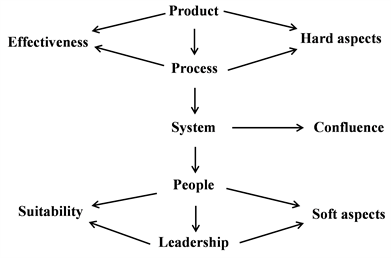Total Quality Management
Introduction to the Philosophy of Total Quality Management
 Graphics courtesy of TATA STEELOpens in new window
Graphics courtesy of TATA STEELOpens in new window
Total quality management (TQM) is an approach to business that looks critically not only at the products and services a company provides in relation to the process it employs to create them, but also at the workforce, to ensure that outputs fully satisfy customer requirements. |
This approach is called “total” because it encompasses everything the company does—all its processes and employees at every level in the company at all times.
TQM is a management philosophy that seeks to integrate all organizational functions (marketing, finance, design, engineering, production and customer service, etc.) to focus on meeting customer needs and organizational objectives.
TQM is a necessity. It is a journey that focus will never end. It is a totally integrated effort directed at gaining competitive advantage by continuously improving every facet of an organization’s activities.
One theory has it that TQM was created as a result of a misinterpretation of the Japanese words for “control” and “management” since no difference exists between these words in Japanese. William Golimski, an American quality scholar and consultant, refers to Koji Kobayashi, former CEO of Nippon Electrical Company (NEC) as being the first to use the words TQM during a speech when he received the Deming prize in 1974.
The American Society for QualityOpens in new window says that the term total quality management was used by the US Naval Air Systems CommandOpens in new window in 1984 to describe its Japanese-style management approach to quality improvement since they did not like the word “control” in the term total quality control.
The word “management” was then suggested by one of the employees, Nancy Warren. This is consistent with the story which states that the United States Navy Personnel Research and Development Center began researching the use of statistical process control (SPC), the works of Juran, Crosby, Ishikawa and the philosophy of W. Edwards Deming to initiate performance improvements in 1984. This approach was first tested at the North Island Naval Aviation DepotOpens in new window.
Definitions of TQM
TQM is an integrated effort designed to improve quality performance at every level of the organization.
- Total: Quality involves everyone and all the activities performed in the company.
- Quality: Conformance to the requirements (meeting customer requirements).
- Management: Quality can and must be managed.
Therefore, TQM is a process for managing quality. It is viewed as a continuous way of life and a philosophy of perpetual improvement in everything we do.
According to the British Standard BS 7850, TQM is defined as,
“Management philosophy and company practices that aim to harness the human and material resources of an organization in the most effective way to achieve the objectives of the organization.”
Also, TQM is defined as a management approach that tries to achieve and sustain long-term organizational success by encouraging employee feedback and participation, satisfying customer needs and expectations, respecting societal values and beliefs and obeying governmental statutes and regulations.
As Figure X-1 shows, product, process, system, people and leadership form the five pillars of TQM.
 Figure X-1. The five pillars of TQM
Figure X-1. The five pillars of TQM
|
TQM is a management philosophy, a paradigm and an approach to continuous improvement in business through a new management model. The TQM philosophy evolved from the continuous improvement with focus on quality as the main dimension of business.
Emphasizing the quality of the product or service predominates the essence of TQM. This expands beyond statistical process control to embrace a wider scope of management activities surrounding people and organizations by focusing on the entire process and not just simple measurements.
TQM is a comprehensive management system which:
- Focuses on meeting the needs of the owners’ or customers’ by providing quality services at a cost that offers value to the owners/customers.
- Is driven by the quest for continuous improvement in all operations.
- Recognizes that everyone in the organization has internal or external owners or customers.
- Views an organization as an internal system with a common aim rather than as individual departments acting to maximize their own performances .
- Focuses on the way tasks are accomplished rather than simply on what tasks are accomplished.
- Emphasizes on teamwork.
- Goetz, A. (1973). “The Laws of Eshunnana.” In James B. Pritchard, Ed. The Ancient Near East, Vol. 1. Princeton University Press, Princeton, NJ.
- Meek, T. J. (1973). “The code of Hammurabi.” In James B. Pritchard, Ed. The Ancient Near East, Vol. 1. Princeton University Press, Princeton, NJ.
- Guerdan, R. (1956). Byzantium: Its Triumphs and Tragedy. George Allen, New York.
- Durant, W. (1954). Our Oriental Heritage. Simon & Schuster. New York.
- CEEM Information System (October 1993). Quality Systems Update.
- Crosby, P. (1985). Quality Improvement Through Defect Prevention. Philip Crosby Associates, Winter Park, FL.
- Duncan, A. J. (1986). Quality Control and Industrial Statistics, 5th ed. Irwin, Homewood, IL.
- Hagigh, S. (Feb. 24, 1992). “Obtaining EC product approvals after 1992: what American manufacturers need to know.” Business America.
- Kokla, J. W., and Scott G. G. (1992). Product Liability and Product Safety Directives. CEEM Information Services, Fairfax, VA.
See Also:

